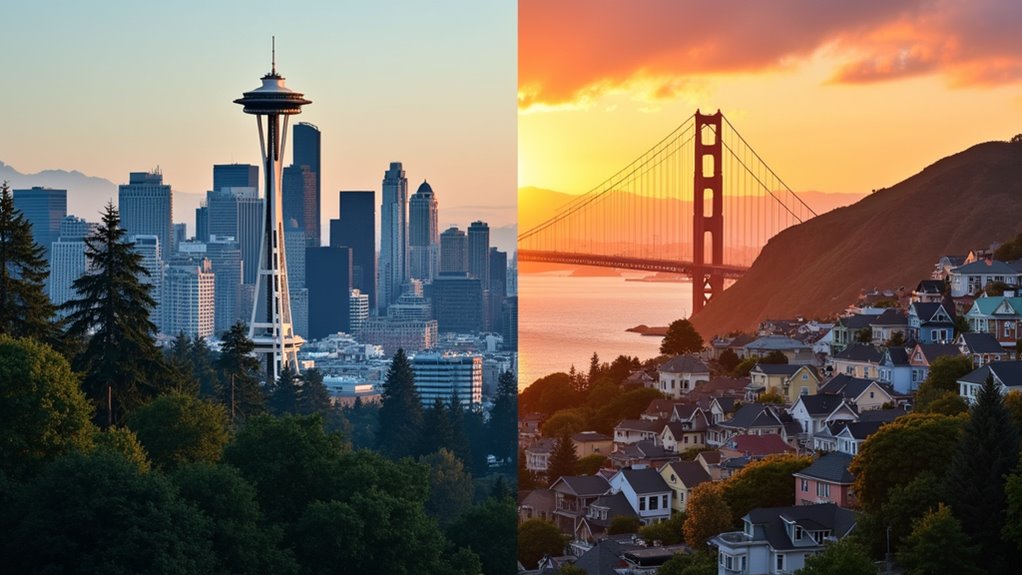Physical Address
304 North Cardinal St.
Dorchester Center, MA 02124
Physical Address
304 North Cardinal St.
Dorchester Center, MA 02124

Hanging between Seattle's outdoor paradise and San Francisco's cultural mecca, discover which tech hub truly matches your lifestyle priorities.
Choosing between Seattle and San Francisco is like deciding between a robust dark roast and a complex espresso—both offer distinctive flavors but satisfy different palates. You’ll notice Seattle’s rapid growth has created a more affordable tech hub with abundant outdoor access, while SF’s established cultural scene and milder climate come with premium pricing. Your career goals, lifestyle preferences, and budget will ultimately determine which city feels like home. The question isn’t which city is objectively better, but which one better aligns with your priorities.

While coastal cities compete for dominance, Seattle’s ascendancy in population growth has become undeniable. You’ll find the Emerald City approaching 800,000 residents in 2024, poised to overtake San Francisco by 2025. Seattle’s explosive 1.6% annual growth rate demolishes the national average of 1%.
Unlike San Francisco’s restrictive zoning that stifles development, Seattle’s expanding transit network is fueling growth in satellite cities like Redmond and Tacoma. Seattle has fully rebounded from pandemic losses (+126,000 since 2020) while San Francisco still lags. This trend demonstrates significant regional variability in urban demographic patterns across the West Coast.
If you’re weighing relocation options, note that Seattle’s growth relies heavily on international migration, offsetting domestic outflows. The city’s housing challenges remain serious, with critics rightfully slamming its 10-year growth plan for insufficient construction targets. Choose wisely.
Although tech giants have planted their flags in both cities, Seattle’s software engineering workforce now outpaces San Francisco’s despite the Bay Area’s longer tech legacy. But don’t be fooled – San Francisco still dominates financially with tech salaries averaging $185,425 versus Seattle’s $172,009.
Seattle’s tech workforce surpasses San Francisco in size, while the Bay Area maintains its financial edge through higher compensation.
California’s tech sector generates a staggering $623.4 billion in economic output, dwarfing Seattle’s entire metro economy of $517.8 billion. Your dollar stretches further in Seattle, where companies pay less for operations while still attracting top talent. Seattle continues to attract new tech professionals due to its lower cost of living compared to the Bay Area. Much like Michigan’s diverse snake species adapting to different environments, both cities have developed unique tech ecosystems shaped by their regional characteristics.
The Bay Area remains America’s most expensive tech market.
Both cities face similar talent shortages, importing workers beyond what local universities produce. If you’re weighing career options, Seattle offers faster growth for early-career professionals, while San Francisco remains the epicenter of startup culture.

Despite its robust tech presence, Seattle delivers markedly more bang for your housing buck compared to San Francisco’s exorbitant prices. The $418,000 price gap between the cities speaks volumes—SF’s median home costs a staggering $1,237,600 versus Seattle’s $819,000.
You’ll need 50% higher income to afford a San Francisco home, where appreciation rates have hit 10.8% annually and property taxes run higher at 1.18% versus Seattle’s 0.93%. If you’re considering coastal properties, Seattle offers more secure housing options compared to San Francisco’s earthquake vulnerabilities.
While both cities face inventory shortages, Seattle’s housing stock offers better value with lower maintenance costs and energy bills. Notably, Seattle’s homes are generally newer with only 12.2% built pre-1940 compared to San Francisco’s 46.2%.
For 2026, Seattle’s projected ceiling of $851,000 remains far below San Francisco’s $1.29M baseline. Unless you’re swimming in tech money or investment capital, Seattle’s housing market offers the clear financial advantage.
When comparing cultural attractions, both cities boast impressive offerings, but they serve distinctly different palates. San Francisco delivers iconic landmarks like the Golden Gate Bridge and Alcatraz Island alongside world-class art at SFMOMA. Seattle counters with the Space Needle and Pike Place Market’s authentic bustle.
For outdoor enthusiasts, your money stretches further in Seattle with easy access to three national parks within a 3-hour drive. The Olympic rainforests and Cascade mountains offer wilderness that California’s crowded trails can’t match. San Francisco’s Muir Woods and Point Reyes provide stunning day trips, but you’ll battle tourist crowds. San Francisco’s natural attractions prominently feature coastal and bay views, creating a different outdoor experience than Seattle’s mountain-focused adventures.
Seattle’s winter sports access (just an hour to Snoqualmie) gives it the edge for year-round recreation, while SF’s milder weather means more reliable hiking conditions. Your destination choice ultimately depends on whether you prefer Seattle’s lush greenery or San Francisco’s island paradise vibe reminiscent of tropical getaways.

The climate debate between Seattle and San Francisco often shapes residents’ daily lives more than any cultural attraction could. You’ll trade Seattle’s 38 inches of yearly rainfall and 155 wet days for San Francisco’s drier 21.7 inches spread across just 68 days. For outdoor enthusiasts, San Francisco’s proximity to coastal areas like Sanibel Island provides excellent snorkeling opportunities throughout most of the year.
SF’s stunning 259 sunny days crush Seattle’s 152—a 70% advantage that’s hard to ignore.
Temperature-wise, Seattle swings wider (38-73°F) while SF stays moderate year-round (45-70°F). Both cities rarely exceed 90°F, but Seattle gets colder winters. San Francisco’s consistently milder temperatures throughout the year make it more comfortable for those who dislike seasonal extremes.
Your sustainability priorities matter too. SF mandates 100% renewables by 2030 and requires solar panels on new buildings, while Seattle’s already at 88% renewable energy (mostly hydro) and focuses on achieving 30% tree canopy by 2037.
SF’s impressive 80% waste diversion beats Seattle’s 70% target.
You’ll find Seattle’s growth exciting until you’re stuck in traffic that rivals SF’s infamous gridlock. Don’t fool yourself—tech bros dominate both cities, just with different preferred brews. Your dollar stretches further in Seattle, but you’re paying in vitamin D deficiency. SF’s perfect weather comes with perfect homeless encampments. Choose your poison: Seattle’s rain-soaked affordability or SF’s sunshine-taxed bankruptcy. Neither’s perfect, but your wallet decides.